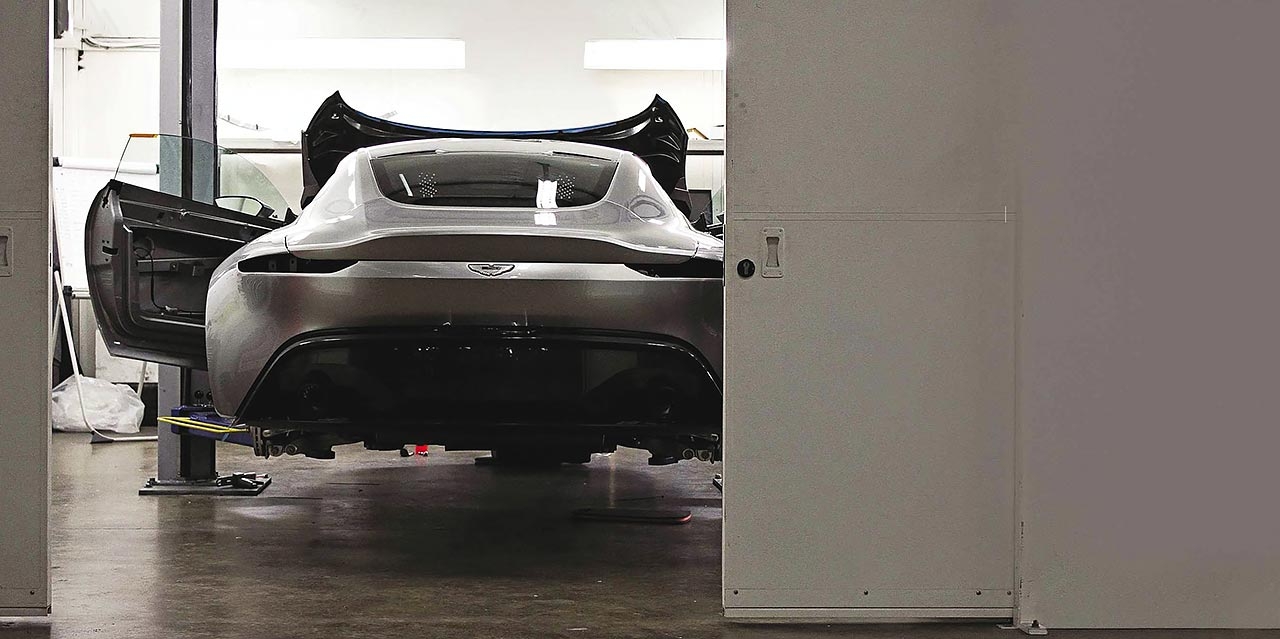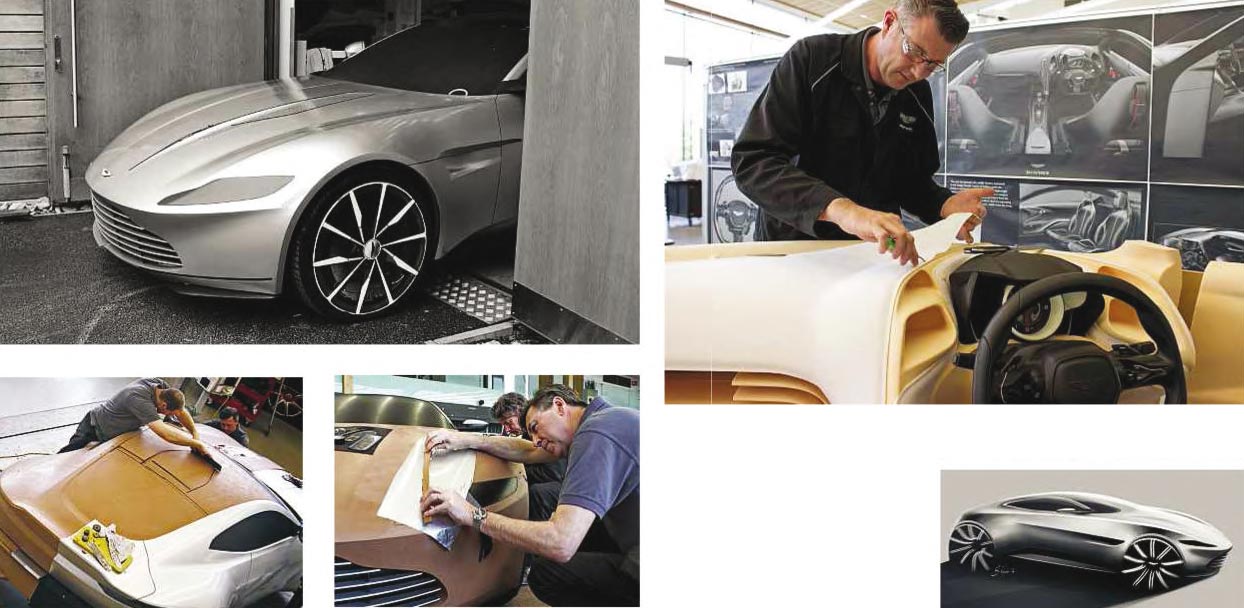
Building the Aston Martin DB10. Vantage Bond Astons inside the DB10 build. Building the Bond cars. Just a year to turn a concept into a fully working car and build ten of them? Sounds like a job for Q. Words Richard Meaden. Images Aston Martin.
Behind the scenes at Aston’s own Q Branch as a concept comes to life. Oh to have been a fly on the wall in the Aston design studio when Sam Mendes, director of Spectre, pointed to a very early concept and said: ‘That’s the car I want in the movie!’ Imagine the forced smiles and nervous laughter as Aston’s design and engineering bigwigs said ‘No problem at all, Mr Mendes’, before breaking out in a cold sweat as the scale of what they’d agreed to began to sink in. Then again, such challenges go with the territory when you’re the go-to guys for James Bond’s company car.
Working closely with Mendes, Marek Reichman’s design team immediately put their minds to the task of developing and refining the concept into a fully formed piece of work. Then it was the turn of David King’s aptly named Q Advanced Engineering department to take that finished design concept and turn it into a living car.

Above and right. The small team at Aston’s Q Advanced Engineering department worked round the clock towards the end of the project to get the cars finished in time. At one stage, five cars were being worked on simultaneously.
Led by Craig Jamieson – seasoned project leader on many of Aston’s Gaydon-era models – a crack team of engineers and technicians was duly assembled and wasted no time in setting to work on engineering and building an all-new car fit to star alongside Daniel Craig, withstand the rigours of filming extreme action sequences and – toughest of all – be worthy of succeeding the most famous movie car of all time, Bond’s truly iconic DB5.
We chat to King and Jamieson just a day after Spectre’s London premiere, a glittering event that publicly marked the culmination of an extraordinary and highly secretive 18-month once-in-a-lifetime project.
‘It all began in the Spring of 2014,’ recalls King. ‘Sam Mendes came to the design studio at Gaydon to look at potential cars for the new movie and fell in love with an early concept clay. Those early days involved meetings down in London between us, Barbara Broccoli, Sam [Mendes] and the creative people from Eon. The script was obviously in the early stages, so they were still looking at locations and what role the car would play in the movie.
‘Our first job was to impress upon Eon that these DB10s weren’t series production cars. We couldn’t just give them 20 cars from the production line. These cars would have to be designed, engineered, tooled and manufactured as a series of concept cars. Initially Eon were talking about having finished cars before the end of the year (2014), when all we had at that time (Spring) was a clay model. The timescales were quite scary.’
Having known DK for a decade or more, I can tell you ‘quite scary’ actually means ‘almost impossible’, but, undeterred, he and his band of Q Advanced Engineering brothers faced the challenge in typically stoic fashion.
‘As soon as Marek had completed the design work we were flat-out trying to get all the surfaces signed-off and finished, so we could release surface data to Multimatic, who would produce the tooling for the carbon body panels. Although the cars were concept cars it was very important they didn’t look half-baked. They had to look fully engineered, so we went to a lot of effort with things like door hingeing and window seals. We made dropping glass for the doors. We didn’t want people to say we’d just plonked a jelly-mould body on a spaceframe chassis.’
For Craig Jamieson, building the Bond cars drew on all his previous experience – and required finding some rather unconventional solutions. As he explains, this included chopping off large chunks of his donor cars!
‘Because the shape of the DB10 – especially the roofline – was so different, we decided our best option was to use V8 Roadsters and chop the windscreen header-rails off. This enabled us to fit the new bodywork without too many obstacles. We constructed a spaceframe cage over the passenger compartment, which was then skinned with the carbon bodywork. The chassis was stretched by 65mm, extending the area between the front crash structure and the occupant cell. We widened the track by fitting bespoke wishbones (extended by about 30mm each side) at the front and using conventional wheel spacers at the rear.
‘One of the questions we get asked is, if we had to start with a Vantage, why not the Vl2? But we needed space under the bonnet to fit the kit required for the controls that allowed the “pod cars” to be driven from the roof. The V12 engine bay is pretty tight, so the installation work was only really possible using a V8. Also at this stage we had no idea what gadgets the plot might demand, so we had to “package-protect” to be sure we had the capability to accommodate whatever gizmos Eon might wish to fit.’
The workload may have been huge, but the DB10 team was tiny. The engineering team comprised just three full-time Aston Martin personnel, with support from a few people assigned to the project by Multimatic. In addition, half a dozen Aston build technicians worked on hand-assembling the cars. They focused on the first car to come up with a production process, before splitting into smaller teams as the rest of the cars came on-stream. During the most intensive period, Jamieson and his team were working on five cars simultaneously
Of the ten built, two were ‘pod cars’ with dual controls for a stunt driver in a roof-mounted ‘pod’, four were stunt cars and another four were so-called ‘hero cars’. Each type was quite different in terms of build and purpose. The pod cars had holes drilled in the bodywork so the roof pod could be firmly attached to the spaceframe beneath. These cars used paddleshift ASM gearboxes for ease of control.
The stunt cars’ had more extensive roll-cages to offer greater side impact protection. They also had race seats with bespoke leather covers over the head-rest areas to make them look like the hero cars. Some of the stunt cars were also fitted with gadgets, installed and operated by Eon’s effects team. The four hero cars were cosmetically perfect and used for static and close-up filming.
For Jamieson and his team, the work didn’t stop when the cars were built: ‘We spent quite a bit of time working with the stunt drivers to fine-tune things. The DB10 has a similar amount of rubber to the Vanquish, so more grip than grunt, really Adjusting the throttle software meant we could help the drivers a little by giving them a much sharper and more aggressive throttle response.
‘Mechanically the cars were hard as nails. They took a huge amount of punishment. I remember discussing with the stunt team how the car would need to fly 6ft in the air for a distance of 50ft, and thinking “This was never in any of the base car’s design or test requirements!” And we had the design guys telling us the cars had to look as good as possible, so we were juggling huge dynamic demands with trying to retain show-car ride heights. In the end we used adaptive ride height units and a few different damper options, so we could tailor the car for certain sequences.’
For an automotive engineer, and an Aston Martin engineer at that, it doesn’t get much better than building Bond’s car. Unless you also get to drive it, that is.
‘I got to drive the first car before anyone else,’ says Jamieson with understandable glee. ‘Unfortunately I’d been up for an entire week, pulling ridiculous hours to get the car finished. We’d worked though the night before the shakedown at Bruntingthorpe. I love driving and race in my spare time, and I’ve always envied the guys who get to do all the drift stuff. I’d like to say I jumped in and did beautiful smokey slides around Bruntingthorpe, but when my moment came I was so tired and laden with a sense of responsibility that I bottled it! I was glad to just drive it around at 60mph and bring it back in one piece. The drive, in fact the whole project, is something I’ll never forget.’
‘FOR AN AUTOMOTIVE ENGINEER, IT DOESN’T GET MUCH BETTER THAN BUILDING BOND’S CAR’

Above: Clamshell bonnet (top centre) gave unhindered access not only to the V8 engine, but also – with the ‘pod cars’ – to the workings for the dual-control system. Close attention to details like hingeing and window seals helped give the DB10s a fully engineered look.
Designing the Bond car
DESIGN BOSS MAREK REICHMANN TELLS US WHAT THE DB10 MEANS TO HIM, AND WHETHER IT PROVIDES CLUES TO FUTURE ASTONS
As Aston Martin’s chief creative officer, it was Marek Reichman’s decision to accede to Bond director Sam Mendes’ wishes and commit to bringing a 2D concept drawing to life. Like all early concept sketches, the flight of fancy that caught Mendes’ eye was a very long way from being a fully formed design. All credit to Aston Martin’s design team, then, that short of the fine functional detailing a true production car demands, the end result looks remarkably well-resolved.
For Reichman, the DB10 is his opportunity to discuss something genuinely new. No, it’s not a precise blueprint for what he’s doing with DB11 and the subsequent Vantage replacement, but it’s a vivid snapshot of what he’s thinking.
‘First and foremost it’s a movie car, but yes, it does hint at the future shape of Aston Martins,’ confirms Reichman. ‘The overall design has a beautiful form language. It’s very pure and simple, even down to the fact there are no conventional outlets on the bonnet. Of course it features our iconic grille, but it’s hidden in shadow, just like a shark’s mouth. Bond is a predator, and this car shares that darker, predatory character.
One of the most important lines on the car is the one that runs unbroken from the top surface of the front wheelarch, along the flank and across the top of the rear haunch. According to Reichman it’s the defining line of the car: ‘It has both plan curvature and forms a sweeping arc when viewed in profile. For the first time in an Aston Martin it also creates a falling line at the rear, which really helps to punch the wheels out through the rear of the bodywork.’
Strong, individual and original, there’s no doubt the DB10 is a fine piece of work. Perhaps more importantly, it’s also a fine Aston Martin. We can’t wait to see how its influence shapes Gaydon’s next generation of road cars.

From the top. The ‘dressed’ clay model emerges into the viewing garden for assessment by the design team and engineers. Getting to this stage had taken many hours of painstaking modelling. One of the design concept drawings that had so excited Spectre director Sam Mendes.





